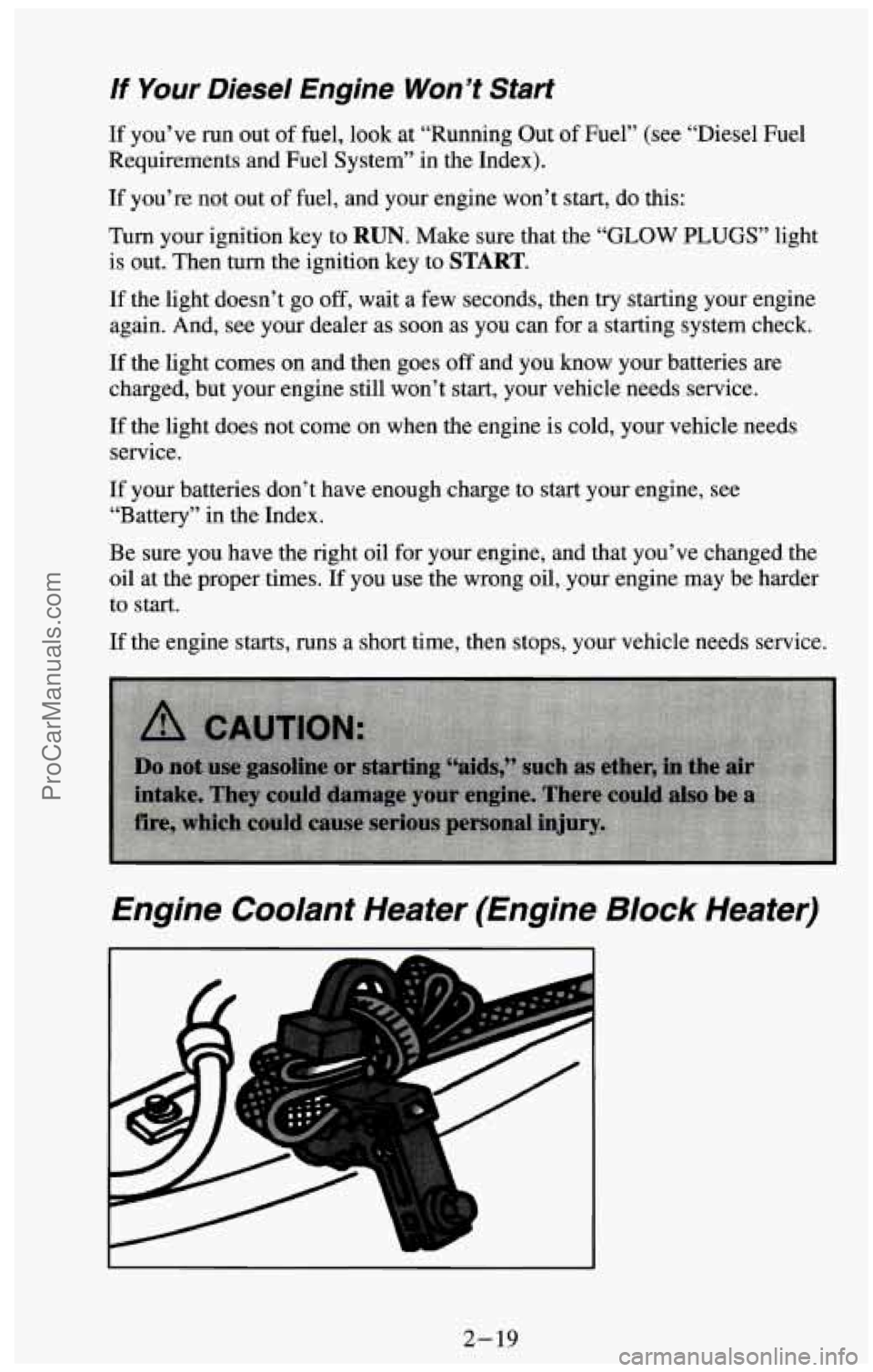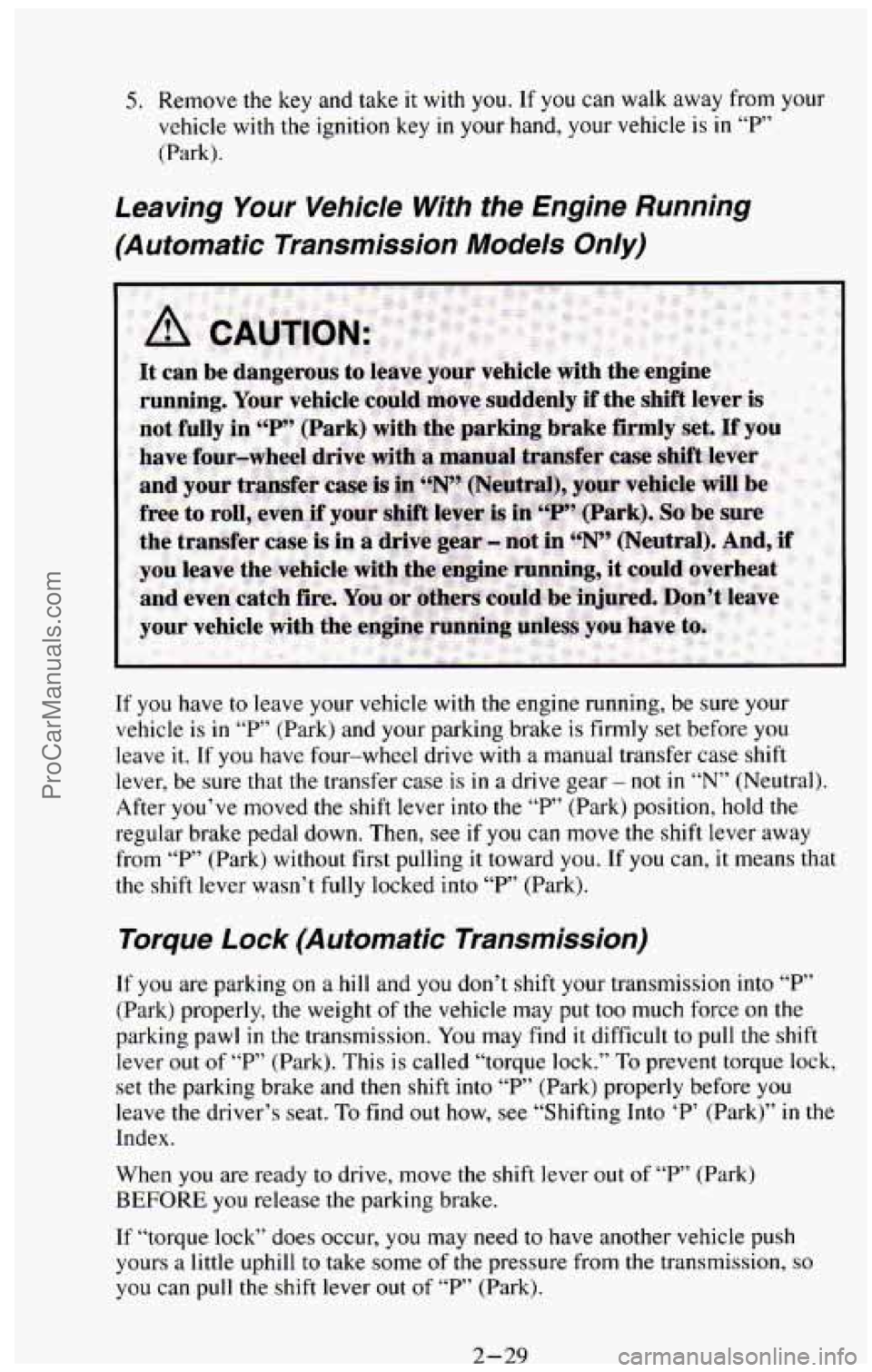Page 71 of 385

Driving In Snow (Diesel Engines)
When driving in a heavy snowstorm or in swirling snow with a diesel
engine, snow can get into
the air intake system. If you keep driving in these
conditions the air cleaner may get plugged, causing black smoke and loss of
power. In an emergency, if the air cleaner gets plugged with snow, you can
remove the air cleaner.
Then, drive to a place of safety as soon as possible
and put the air cleaner back
on.
Starting Your Diesel Engine
Your diesel engine starts differently than a gasoline engine.
1. Automatic Transmission:
Move your shift lever to “P’ (Park) or “N” (Neutral). Your engine
won’t start in any other position
- that’s a safety feature. To restart
when you’re already moving, use
“N” (Neutral) only.
NOTICE:
Don’t try to shift to 4‘P’’ (Park) if your vehicle is moving. If you
do, you could damage the transmission. Shift to
“P” (Park) only
when your vehicle is stopped.
2. Manual Transmission:
Move your shift lever to neutral and hold the clutch pedal to the floor
while starting
the engine. Your vehicle won’t start if the clutch pedal is
not all the way down - that’s a safety feature.
Turn your ignition
key to RUN. Don’t turn it to START.
With the ignition in RUN, the “GLOW PLUGS” light will come on. If
the engine is already warm, this light may
not come on. That’s normal.
During starting, your “GLOW
PLUGS” light may go on and off a few
times. This
is normal. This means that part of your engine is being
warmed up for better starting. When the light goes off, your engine is
ready to start.
Do not start the engine with this light on.
NOTICE:
If the “GLOW PLUGS” light stays on, it means that your
vehicle could have one
of several problems, so you should have it
serviced right away.
2-16
ProCarManuals.com
Page 72 of 385

3. If this light does not come on, or the instant the light goes off, turn your
ignition key to
START. When the engine starts, let go of the key.
NOTICE:
Holding your key in “Start” for longer than 15 seconds at a time
will cause your battery to be drained much sooner. And the
excessive heat can damage your starter motor.
4. If the engine does not start after 15 seconds of cranking, turn the
ignition key to
OFF. Wait one minute for the starter to cool, then try
the same steps again.
If you’re trying to start your engine after you’ve run out of fuel, follow the
steps
in “Running Out of Fuel” (see “Diesel Fuel Requirements and Fuel
System”
in the Index).
When your engine
is cold, let it run for a few minutes before you move your
vehicle. This lets oil pressure build up. Your engine
will sound louder when
it’s cold.
NOTICE:
If you’re not in an idling vehicle and the engine overheats, you
wouldn’t be there to see the coolant temperature gage. This
could damage your vehicle. Don’t let your engine run when
you’re not in your vehicle.
Cold Weather Starting (Diesel Engine)
The following tips will help you get good starting in cold weather.
Use
SAE low-30 oil when the outside temperature drops below freezing.
When the outside temperature drops below 0°F
(-I S’C), use your engine
coolant heater.
If
you park your vehicle in a garage, you shouldn’t need to use the coolant
heater
until the garage temperature goes below 0°F (-1 Sac), no matter how
cold
it is outside.
2- 17
ProCarManuals.com
Page 74 of 385

If Your Diesel Engine Won’t Start
If you’ve run out of fuel, look at “Running Out of Fuel” (see “Diesel Fuel
Requirements and Fuel System” in the Index).
If you’re not out of fuel, and your engine won’t start, do this:
Turn your ignition key to RUN. Make sure that the “GLOW PLUGS” light
is out. Then turn the ignition key to
START.
If the light doesn’t go off, wait a few seconds, then try starting your engine
again. And, see your dealer as soon as you can for a starting system check.
If the light comes on and then goes off and you know your batteries are
charged, but your engine still won’t start, your vehicle needs service.
If the light does not come
on when the engine is cold, your vehicle needs
service.
If your batteries don’t have enough charge to start your engine, see
“Battery” in the Index.
Be sure you have the right oil for your engine, and that you’ve changed the
oil at the proper times. If you use the wrong oil, your engine may be harder
to start.
If the engine starts, runs a short time, then stops, your vehicle needs service.
Engine Coolant Heater (Engine Block Heater)
2- 19
ProCarManuals.com
Page 83 of 385
Shifting Into “P” (Park)
(Automatic Transmission Models Only)
Steering Column Shift Lever
1. Hold the brake
pedal down with
your right
foot
and set the
parking brake.
2. Move the shift lever into “P” (Park) position like this:
0 Pull the lever toward you.
0 Move the lever up as far as it will go.
3. If you have four-wheel drive, be sure the transfer case is in a drive gear
- not in “N’ (Neutral)
4. Move the ignition key to LOCK.
2-28
ProCarManuals.com
Page 84 of 385

5. Remove the key and take it with you. If you can walk away from your
vehicle with the ignition key in
your hand, your vehicle is in “P”
(Park).
If
you have to leave your vehicle with the engine running, be sure your
vehicle
is in “P’ (Park) and your parking brake is firmly set before you
leave it. If
you have four-wheel drive with a manual transfer case shift
lever, be sure that
the transfer case is in a drive gear - not in “N” (Neutral).
After
you’ve moved the shift lever into the “P” (Park) position, hold the
regular brake pedal down. Then, see if
you can move the shift lever away
from “P” (Park) without first pulling it toward you. If
you can, it means that
the shift lever wasn’t fully locked into
“I?” (Park).
Torque Lock (Automatic Transmission)
If you are parking on a hill and you don’t shift your transmission into “P”
(Park) properly, the weight of the vehicle may put
too much force on the
parking pawl in the transmission. You may find it difficult to pull the shift
lever
out of “P” (Park). This is called “torque lock.’’ To prevent torque lock,
set the parking brake and then shift into
“P’ (Park) properly before you
leave the driver’s seat. To find out how, see “Shifting Into ‘P’ (Park)” in the
Index.
When
you are ready to drive, move the shift lever out of “P” (Park)
BEFORE you release the parking brake.
If “torque lock”
does occur, you may need to have another vehicle push
yours a little uphill to take some
of the pressure from the transmission, so
you can pull the shift lever out of “F”’ (Park).
2-29 ProCarManuals.com
Page 112 of 385
Two cup depressions
are provided for your
convenience.
Center Floor Console
Your vehicle may have a console compartment between the bucket seats.
To open it, just
squeeze the buttons on
both sides
of the
keyhole, and pull up.
Use your round key to
lock this
compartment.
Your console also
includes a handy place
to hold cups.
2-57
ProCarManuals.com
Page 121 of 385

Tachometer
4
If you have a
tachometer,
it displays
the engine speed in
revolutions per minute
(rpm).
I NOTICE:
Do not operate the engine with the tachometer in the red area,
your engine
or other parts could be damaged.
Damage to your engine
or vehicle caused by operating the
engine in the red area isn't covered by your vehicle warranty.\
Warning Lights andl Indicators
This section describes the warning lights and gages that may be on your
vehicle. The pictures will help you locate them.
Warning lights and gages can signal that something
is wrong before it
becomes serious enough to cause
an expensive repair or replacement.
Paying attention to your warning lights and gages could also save you or
others from injury.
Warning lights
go on when there may be or is a problem with one of your
vehicle's functions.
As you will see in the details on the next few pages,
some warning lights come on briefly when you turn the ignition key
just to
let you know they're working. If you are familiar with this section, you
should not be alarmed when this happens.
Gages can indicate when there may be or is a problem with one of your
vehicle's functions. Often gages and warning lights work together
to let you
know when there's
a problem with your vehicle.
When one
of the warning lights comes on and stays on when you are
driving,
or when one of the gages shows there may be a problem, check the
section that tells you what to
do about it. Please follow the manual's advice.
2-66
ProCarManuals.com
Page 162 of 385

According to the American Medical Association, a 180-pound (82 kg)
person who drinks three 12-ounce
(355 ml) bottles of beer in an hour will
end up with a BAC of about
0.06 percent. The person would reach the same
BAC by drinking three 4-ounce (120
ml) glasses of wine or three mixed
drinks
if each had 1-112 ounces (45 ml) ofya liquor like whiskey, gin or
vodka.
~~ ~
It's the amount of alcohol that counts. For example, if the same person
drank three double martinis
(3 ounces or 90 ml of liquor each) within an
hour, the person's BAC would be close to 0.12 percent. A person who
consumes food just before
or during drinking will have a slightly lower
BAC level.
3 HOUU§
2 HOURS
1 HOUR
The law in most U.S. states sets the legal limit at a BAC of 0.10 percent. In
Canada the limit is
0.08 percent, and in some other countries it's lower than
that. The BAC will be over 0.10 percent after three to six drinks (in one
hour).
Of course, as we've seen, it depends on how much alcohol is in the
drinks, and how quickly the person drinks them.
4-3
ProCarManuals.com